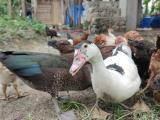Sep 13, 2005 (CIDRAP News) – European researchers have reported what they call the first evidence that low-pathogenic avian influenza (LPAI) viruses—not just highly pathogenic (HPAI) strains like H5N1—can infect humans.
The finding in a study of Italian poultry workers suggests that avian flu viruses have more chances than previously suspected to mix with human flu viruses, potentially creating hybrids that could trigger a human flu pandemic, according to the report published online by the Journal of Infectious Diseases.
The researchers, led by Isabella Donatelli of the Instituto Superiore di Sanita in Rome, took serum samples from 983 workers at several farms in northern Italy from August 1999 until July 2003. Several avian flu outbreaks occurred there during that period, including both LPAI and HPAI strains of H7N1 and an LPAI H7N3 strain. (LPAI viruses cause mild illness and few deaths in poultry, while HPAI viruses cause severe illness with high death rates.)
The serum samples were tested for antibodies to the avian viruses. To ensure accuracy, the researchers tested each sample with hemagglutination inhibition (HI) and microneutralization (MN) assays. If either of these came back positive, a Western blot analysis was done.
None of the 798 serum samples collected during or after the first four outbreaks tested positive for antibodies to H7N1 or H7N3 viruses. However, 7 of 185 samples (3.8%) taken during an H7N3 outbreak in 2002 and 2003 tested positive for both viruses in the MN assay, and 4 of those 7 tested positive for both viruses in the HI assay. Both tests showed higher titers of antibodies to the H7N3 (LPAI) strain. In the Western blot testing, all seven samples showed clear reactivity, unlike control samples (which had tested negative in the HI and MN assays).
All the workers who tested positive had had close contact with turkeys or chickens in dusty poultry houses, the authors report. None of the workers reported any flu-like illness at the time of the avian flu outbreaks, and only one reported symptoms of conjunctivitis, an ailment seen in some Dutch poultry workers during an HPAI outbreak in 2003.
"To our knowledge, this is the first serological evidence of transmission of LPAI viruses to humans during an epizootic in domestic poultry," the report says. It adds that reports of human infections associated with other avian flu outbreaks—in the Netherlands, Vietnam, Thailand, Cambodia, Hong Kong, and Canada—have all involved HPAI strains.
The researchers call for "permanent" surveillance for avian flu viruses in both animals and humans to shed more light on how the viruses jump the species barrier.
"Our findings highlight the risk of the emergence of a potentially pandemic strain, as a result of reassortment of avian and contemporaneously circulating human strains during outbreaks of AI [avian influenza] caused by LPAI viruses," they write.
The authors also say, according to a Journal of Infectious Diseases news release, that poultry workers should be regularly vaccinated against ordinary flu to reduce the risk of gene-swapping between avian and human flu strains.
Puzelli S, Di Trani L, Faviani C, et al. Serolgoical analysis of serum samples from humans exposed to avian H7 influenza viruses in Italy between 1999 and 2003. J Infect Dis 2005 Oct 15;192(8):1318-22 [Full text]
See also:
Commentary on Puzelli article in same issue of JID [Full text]



















